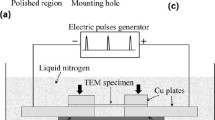Abstract
For the purpose of clarification of the mechanisms of the electron-plastic effect the influence of current pulses with a length of 2·10−4 sec and a density of more than 20 MA/m2 on the mobility of pyramidal dislocations in Zn single crystals in the area of thermally activated movement at 77 and 293 K and also on their multiplication was studied by the method of selective etching. It was shown that the increase in the rate of movement of dislocations under the action of current pulses is accompanied by multiplication of the dislocations with current densities of more, than 102 MA/m2. The rules established are discussed taking into consideration the pondermotive forces, thermal effects, electron-dislocation interaction, and the work of the Frank-Reid effect under the action of the electron wind.
Similar content being viewed by others
Literature Cited
V. I. Spitsyn and O. A. Troitskii, Electroplastic Deformation of Metals [in Russian], Nauka, Moscow (1985).
A. F. Sprecher, S. L. Mannan, and H. Conrad, “On the mechanisms for the electroplastic effect in metals,” Acta Met.,34, 1145–1162 (1986).
K. M. Klimov and I. I. Novikov, “The question of the electroplastic effects,” Probl. Prochn., No. 2, 98–103, 107–108 (1984).
L. S. Novogrudskii, O. Ya. Znakovskii, and V. A. Stepnenko, “Features of the deformation and failure of 12Kh18N1OT and 03Kh12AG19 steels under the action of a pulsed electrical current and cooling to 4.2 K,” Probl. Prochn., No. 4, 60–63 (1985).
V. V. A. Strizhalo, L. S. Novogrudskii, and O. Ya. Znachkovskii, “The deformation resistance of constructional alloys under the action of a pulsed electrical current and cryogenic temperatures,” Probl. Prochn., No. 5, 105–107.
V. Ya. Kravchenko, “The action of a directed flow of electrons on dislocations,” Zh. Éksp. Teor. Fiz.,51, No. 9, 1676–1688 (1966).
G. P. Huffman and N. Louat, J. A. Simmons, R. de Wit, and Bullough (eds.), Fundamental Aspects of Dislocation Theory, National Bureau of Standards (U.S.) Special Publication, Vol. 11 (1970), pp. 1303–1322.
Yu. I. Boiko, E. Ya. Geguzin, and Yu. I. Klinchuk, “Experimental observation of the increase in dislocations by the electron wind in metals,” Pis'ma Zh. Éksp. Teor. Fiz.,30, No. 3, 168–172 (1979).
O. A. Troitskii, A. M. Rashchupkin, V. I. Stashenko, et al., “The Development of concepts of the direct physical action of a current in the electron-plastic effect,” Fiz. Met. Metaloved.,61, No. 8, 990–995 (1986).
V. B. Fiks, “The interaction of conduction electrons with single dislocations in metals,” Zh. Éksp. Teor. Fiz.,80, No. 7, 2313–2316 (1981).
V. Z. Bengus, “The rate of multiplication and sources of mobile dislocations,” in: The Dynamics of Dislocations [in Russian], Naukova Dumka, Kiev (1975), pp. 315–332.
V. A. Makara and O. V. Rudenko, “The presence of a corrélation between movement and multiplication of dislocations,” in: The Dynamics of Dislocations [in Russian], Naukova Dumka, Kiev (1975), pp. 349–355.
V. A. Kuznetsov, V. E. Gromov, and L. I. Gurevich, “A unit for studying the electrostimulated mobility of dislocations,” Zavod. Lab., No. 7, 32–35 (1987).
V. A. Kuznetsov, V. E. Gromov, and V. P. Simakov, “A generator of powerful current pulses,” Takh. Élektrodinamika, No. 5, 46–49 (1981).
V. A. Kuznetsov, V. E. Gromov, and L. I. Gurevich, “Evaluation of the maximum current of a pulse generator,” Élektron. Obrab. Mater., No. 5, 89–91 (1986).
F. S. Novik and L. B. Arsov, Optimization of the Processes of the Technology of Metals by Experiment Planning Methods [in Russian], Mashinostroenie, Moscow (1980).
E. M. Nadgornyi, “The dynamic properties of isolated dislocations,” in: Imperfections of the Crystalline Structure and Martensite Transformations [in Russian], Nauka, Moscow (1972), pp. 151–175.
L. Girifalco, Statistical Physics of Materials, Wiley, New York (1973).
I. Kittel', Introduction to the Physics of a Solid [in Russian], Nauka, Moscow (1978).
V. P. Lebedev and V. I. Khotkavich, “The influence of current pulses on the low-temperature deformation of aluminum,” Fiz. Met. Metalloved.,54, No. 3, 353–360 (1982).
I. V. Gektina, F. F. Lavrent'ev, and V. I. Startsev, “The influence of temperature and the degree of structural perfection on viscous retarding of dislocations in NaCl crystals,” in: The Dynamics of Dislocations [in Russian], Naukova, Dumka, Kiev (1975), pp. 285–290.
V. I. Al'shits, E. V. Darinskaya, and T. M. Perekalina, “The movement of dislocations in NaCl crystals under the action of a permanent magnetic field,” Fiz. Tverd. Tela,29, No. 5, 467–471 (1987).
F. Khirt and I. Lote, The Theory of Dislocations [in Russian], Atomizdat, Moscow (1972).
Additional information
S. Ordzhonikidze Siberian Metallurgical Institute, Novokuznetsk. Translated from Problemy Prochnosti, No. 10, pp. 48–53, October, 1989.
Rights and permissions
About this article
Cite this article
Gromov, V.E., Gurevich, L.I., Kurilov, V.F. et al. Influence of current pulses on the mobility and multiplication of dislocations in Zn. Strength Mater 21, 1335–1341 (1989). https://doi.org/10.1007/BF01529261
Received:
Issue Date:
DOI: https://doi.org/10.1007/BF01529261



